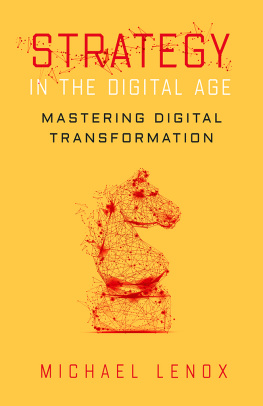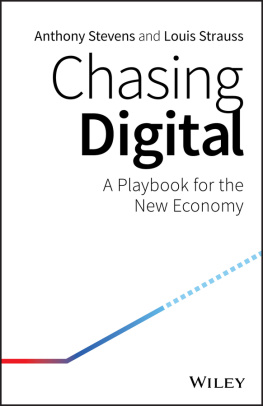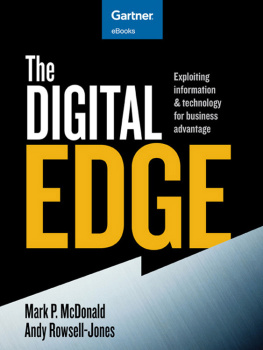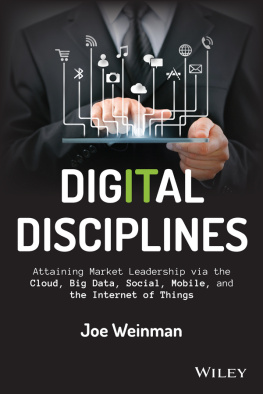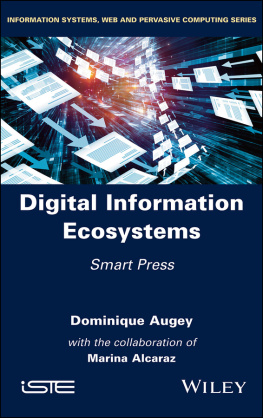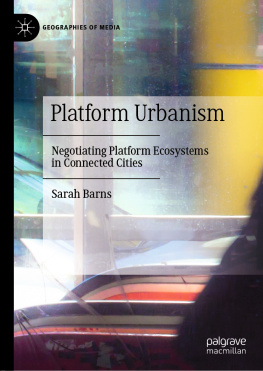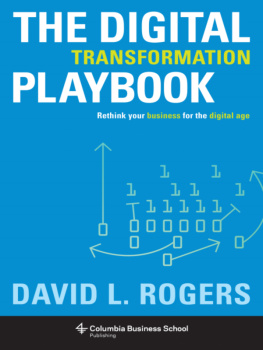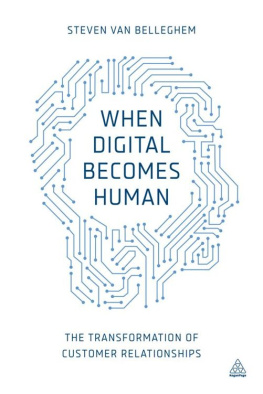
The Future of Competitive Strategy
Management on the Cutting Edge
Robert Holland, series editor
Published in cooperation with MIT Sloan Management Review
The AI Advantage: How to Put the Artificial Intelligence Revolution to Work
Thomas H. Davenport
The Technology Fallacy: How People are the Real Key to Digital Transformation
Gerald C. Kane, Anh Nguyen Phillips, Jonathan Copulsky, and Garth Andrus
Designed for Digital: How to Architect Your Business for Sustained Success
Jeanne W. Ross, Cynthia Beath, and Martin Mocker
See Sooner, Act Faster: How Vigilant Leaders Thrive in an Era of Digital Turbulence
George S. Day and Paul J. H. Schoemaker
Leading in the Digital World: How to Foster Creativity, Collaboration, and Inclusivity
Amit S. Mukherjee
The Ends Game: How Smart Companies Stop Selling Products and Start Delivering Value
Marco Bertini and Oded Koenigsberg
Open Strategy: Mastering Disruption from Outside the C-Suite
Christian Stadler, Julia Hautz, Kurt Matzler, and Stephan Friedrich von den Eichen
The Transformation Myth: Leading Your Organization through Uncertain Times
Gerald Kane, Rich Nanda, Anh Nguyen Phillips, and Jonathan Copulsky
Winning the Right Game: How to Disrupt, Defend, and Deliver in a Changing World
Ron Adner
The Digital Multinational: How to Connect and Compete in a (De)Globalized World
Satish Nambisan and Yadong Luo
Work without Jobs: How to Reboot Your Organizations Work Operating System
Ravin Jesuthasan and John W. Boudreau
Productive Tensions: How Every Leader Can Tackle Innovations Toughest Trade-Offs
Christopher B. Bingham and Rory M. McDonald
The Future of Competitive Strategy: Unleashing the Power of Data and Digital Ecosystems
Mohan Subramaniam

The Future of Competitive Strategy
Unleashing the Power of Data and Digital Ecosystems
Mohan Subramaniam
The MIT Press
Cambridge, Massachusetts
London, England
2022 Massachusetts Institute of Technology
All rights reserved. No part of this book may be reproduced in any form by any electronic or mechanical means (including photocopying, recording, or information storage and retrieval) without permission in writing from the publisher.
The MIT Press would like to thank the anonymous peer reviewers who provided comments on drafts of this book. The generous work of academic experts is essential for establishing the authority and quality of our publications. We acknowledge with gratitude the contributions of these otherwise uncredited readers.
This book was set in ITC Stone Serif Std and ITC Stone Sans Std by New Best-set Typesetters Ltd.
Library of Congress Cataloging-in-Publication Data
Names: Subramaniam, Mohan, author.
Title: The future of competitive strategy : unleashing the power of data and digital ecosystems / Mohan Subramaniam. Management on the cutting edge | Includes bibliographical references and index. | Digital media. | Competition.
Description: Cambridge, Massachusetts : The MIT Press, [2022] | Series:
Identifiers: LCCN 2021033927 | ISBN 9780262046992 (hardcover)
Subjects: LCSH: Strategic planningMethodology. | Digital communications.
Classification: LCC HD30.28 .S85 2022 | DDC 658.4/012dc23/eng/20211015
LC record available at https://lccn.loc.gov/2021033927
10 9 8 7 6 5 4 3 2 1
d_r0
Contents
Series Foreword
The world does not lack for management ideas. Thousands of researchers, practitioners, and other experts produce tens of thousands of articles, books, papers, posts, and podcasts each year. But only a scant few promise to truly move the needle on practice, and fewer still dare to reach into the future of what management will become. It is this rare breed of ideameaningful to practice, grounded in evidence, and built for the futurethat we seek to present in this series.
Robert Holland
Managing Director
MIT Sloan Management Review
Preface
My association with the field of competitive strategy began over thirty years back when I started my doctoral studies. Industrial organizational economics then had a significant influence on this field. It helped frame competitive strategy in the context of a firms industry. Industry characteristics influence a firms profitability; hence it made sense for firms to compete in ways that best marshalled industry forces to their advantage. This perspective offered elegant conceptual frameworks and strong empirical anchors for academics. For practitioners and a vast majority of businesses operating with value-chain-driven business models, this perspective also offered pragmatic approaches for businesses to position themselves within their respective industries and clear guidelines to gain competitive advantage.
By the turn of this century, new technologies began to grab our attention. The power of software became apparent. The internet started changing business processes. We saw exponential advances in digital connectivity and the emergence of digital platforms. Businesses, especially technology companies, started seeing their world around them as ecosystems rather than industries.
Observing these trends, I began to wonder: what would competitive strategy anchored on ecosystems rather than industries look like? Ideas then were fuzzy. But the desire and objectives were clear: first, to develop new frameworks for competitive strategy that gave ecosystems the same depth and rigor as prevailing frameworks did for industries; second, to make these frameworks relevant to a vast majority of industrial firms competing with value-chain business modelsnot just to new technology firms that operated with platform-based business models.
In October 2014, I happened to reconnect with Bala Iyer at a social gathering at a common friends place. I knew Bala from the time he was a newly minted faculty member in the information systems department at Boston University, and I was graduating from my doctoral program in strategic management from the same school. By 2014, he was at Babson, and I was at Boston College. Our conversation turned to ecosystems. There was enough common interest to conclude that we must take our initial conversations further.
We started meeting two to three times a week; our discussions would last for hours. He came from the technology angle, while I offered my strategy perspective. Early thoughts coalesced around how digital ecosystems could be built on the foundations of APIs (application program interfaces). APIs that allow software programs to talk to one another were then well-known to the technology world. For the industrial world, however, their potential to help create new ecosystems were not as obvious. We published a few articles on the strategic significance of APIs to industrial firms.
Bala tragically passed away in his prime, a few years after we started working together. He left behind for me precious seeds of insight that I could grow and nurture.
Around that time, I was also conducting executive education workshops around the world. These workshops gave me the opportunity to present my new thinking to seasoned executives in the digital space and an invaluable forum to expand and refine my ideas. The key elements of a digital ecosystem framework for competitive strategy started taking shape.
Next page

